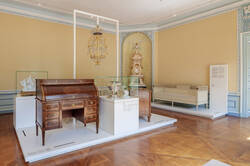Further Media
The room furnished as a bedchamber for the stay of Emperor Leopold II is the largest of the sequence of rooms. Here, objects from the collection of the Kunstgewerbemuseum show the neo-classicist design principles in Saxony around 1800. Although the metropolises of Vienna and Paris, and later also Berlin, were centres of neo-classicism, the following exhibits demonstrate the high level achieved by Saxon arts and crafts at that time.
An example of this is the imposing table centrepiece in the large display case: on a brass base, decorated with medallions of Saxon semi-precious stones, the allegory of the Saxon manufactories, made of Meissen bisque porcelain, is enthroned with self-confidence. The group was created around 1775 by the sculptor and modeller Michel Victor Acier in collaboration with the court jeweller and stone cutter Johann Christian Neuber as part of a large centrepiece for the Saxon Elector Friedrich August III. You remember, the builder of the upper and water-side palace wings of Schloss Pillnitz and host of the "Pillnitz Conference"?
